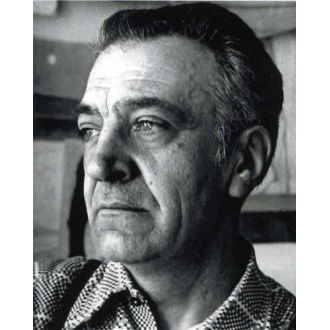Artist
Boris Uspensky

1927-2005
Moscow, USSR
Poster artist, graphic artist, landscape painter
Boris Aleksandrovich Uspensky was born in Moscow, into a family of musicians and clergymen. As a young boy, he loved music, but he found his real passion in the fine arts and in 1942 enrolled at the 1905 Art School. In 1947 he entered the Surikov Institute in Moscow, in the department of painting, but later transferred to the poster studio of the graphics department to study under the famous avant-garde artist Mikhail Cheremnykh, who was to exert a strong influence on the shaping of the young artist.
After graduation in 1953, he started a working partnership with fellow student Oleg Savostyuk. Their friendship and collaboration lasted for many years and proved to be a brilliant success, when they made a complete breakthrough in the poster genre by creating a new style inspired by the Russian folk art Lubok – brightly coloured stories, sometimes in a primitivistic style. “... The innovative feat of these two artists was that they returned the poster to life as a Work of Art after its death in the 1930s” (M. Lazarev). The artists worked mainly with the publishing houses “Izogiz”, “Plakat”, “Sovietskaya Rossiya”, and “Sovietsky Khudozhnik”, and in the famous creative workshop “Agitplakat”. From the mid-1960s Uspensky and Savostyuk often travelled to Karelia, where they created several series of works: “The Loggers of Karelia”, “Border Guards”, and “Karelia”.
In the 1960s Uspensky started working with the Bolshoi Theatre in Moscow, where he was acquainted with the ballet choreographer Yuri Grigorovich and the dancer Vladimir Vasiliev. For the Ballet, Boris Aleksandrovich painted posters and drew illustrations for programmes and librettos, his first poster being “Swan Lake” for the ballet’s tour of France in 1958. Over the next decades he worked on many ballets, including Petrushka, Spartacus, Angara, Ivan the Terrible, Leniniana (after Mayakovsky), Paganini, Chopeniana, and Romeo and Juliet.
This opportunity to see the life of the theatre from the inside, drawing sketches and recording impressions, was decisive in creating a life-long passion for the artist – the ballet. With great enthusiasm he drew and painted ballerinas, danseurs and choreographers in a variety of situations - during and after rehearsals, at the barre, or resting, tired. Boris Aleksandrovich would always return to this theme, working in different media – oil, tempera, gouache, pencil, and silk screen prints.
The artist also loved the town of Tarusa, his father’s birthplace, picturesquely located on the banks of the river Oka. For hours he would admire the scenery, the vast expanses, the river in fog and rain, and the ancient trees. Painting landscapes, his touch was delicate and light.
In his later years, Uspensky gave his heart and soul to his students as professor of the graphical department of the Surikov Institute. Here he helped develop a plethora of talented artists, handing over the artistic baton.
After graduation in 1953, he started a working partnership with fellow student Oleg Savostyuk. Their friendship and collaboration lasted for many years and proved to be a brilliant success, when they made a complete breakthrough in the poster genre by creating a new style inspired by the Russian folk art Lubok – brightly coloured stories, sometimes in a primitivistic style. “... The innovative feat of these two artists was that they returned the poster to life as a Work of Art after its death in the 1930s” (M. Lazarev). The artists worked mainly with the publishing houses “Izogiz”, “Plakat”, “Sovietskaya Rossiya”, and “Sovietsky Khudozhnik”, and in the famous creative workshop “Agitplakat”. From the mid-1960s Uspensky and Savostyuk often travelled to Karelia, where they created several series of works: “The Loggers of Karelia”, “Border Guards”, and “Karelia”.
In the 1960s Uspensky started working with the Bolshoi Theatre in Moscow, where he was acquainted with the ballet choreographer Yuri Grigorovich and the dancer Vladimir Vasiliev. For the Ballet, Boris Aleksandrovich painted posters and drew illustrations for programmes and librettos, his first poster being “Swan Lake” for the ballet’s tour of France in 1958. Over the next decades he worked on many ballets, including Petrushka, Spartacus, Angara, Ivan the Terrible, Leniniana (after Mayakovsky), Paganini, Chopeniana, and Romeo and Juliet.
This opportunity to see the life of the theatre from the inside, drawing sketches and recording impressions, was decisive in creating a life-long passion for the artist – the ballet. With great enthusiasm he drew and painted ballerinas, danseurs and choreographers in a variety of situations - during and after rehearsals, at the barre, or resting, tired. Boris Aleksandrovich would always return to this theme, working in different media – oil, tempera, gouache, pencil, and silk screen prints.
The artist also loved the town of Tarusa, his father’s birthplace, picturesquely located on the banks of the river Oka. For hours he would admire the scenery, the vast expanses, the river in fog and rain, and the ancient trees. Painting landscapes, his touch was delicate and light.
In his later years, Uspensky gave his heart and soul to his students as professor of the graphical department of the Surikov Institute. Here he helped develop a plethora of talented artists, handing over the artistic baton.